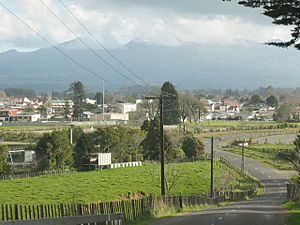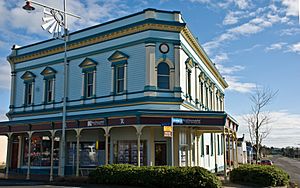Inglewood, New Zealand facts for kids
Quick facts for kids
Inglewood
|
|
|---|---|

A view of Inglewood from Lincoln Road, with Mount Taranaki in the background, hidden by cloud
|
|
| Country | New Zealand |
| Region | Taranaki Region |
| Territorial authority | New Plymouth District |
| Ward |
|
| Community | Inglewood Community |
| Electorates |
|
| Area | |
| • Total | 3.18 km2 (1.23 sq mi) |
| Population
(June 2023)
|
|
| • Total | 3,870 |
| • Density | 1,217/km2 (3,152/sq mi) |
| Postcode(s) |
4330
|
Inglewood is a town in the Taranaki Region of New Zealand's North Island. It is about 16 kilometers (10 miles) southeast of New Plymouth on State Highway 3. The town is close to Mount Taranaki and sits about 200 meters (656 feet) above sea level. Inglewood mainly serves the surrounding dairy farming area.
Contents
History of Inglewood
Inglewood was founded in 1873. It was first called Moatown, then Milton. In 1875, its name changed to Inglewood. This was to avoid confusion with another town called Milton in the South Island.
The railway line reached Inglewood in 1877. This connected the town with New Plymouth. It was part of the first extension of what is now the Marton–New Plymouth line.
For many years, Inglewood was home to a large dairy factory. The Moa-Nui Co-operative Dairies factory was the fourth biggest in New Zealand. It closed in 1991, as dairy processing moved to a central location near Hāwera.
From 1949 until the late 1980s, Inglewood was famous for Fun Ho! Toys. This company made collectible die-cast metal toys. It was one of New Zealand's biggest toy companies. The factory closed in 1987. However, there is still a museum in town. It displays over 3000 Fun Ho! toys.
Several buildings in Inglewood are special. They are listed by Heritage New Zealand. The Railway Station and Yard is a Category I listed building. The Shoe Store Building is also important. It is one of eight buildings listed as Category II.
Te Kōhanga Moa Marae
Te Kōhanga Moa Marae is located in Inglewood. A marae is a special meeting place for Māori people. It has a meeting house called Matamua. This marae is connected to the Te Āti Awa hapū (sub-tribe) of Pukerangiora.
In October 2020, the New Zealand Government helped upgrade this marae. They provided funds to improve it and another marae. This project also helped create 15 jobs in the area.
Inglewood's Population
Inglewood covers an area of about 3.18 square kilometers. As of 2018, it had an estimated population of 3,870. This means there are many people living in a small area.
The town's population has grown over the years. In 2006, there were 3,087 people. By 2013, it grew to 3,243. In 2018, the population reached 3,543. This shows a steady increase in the number of residents.
In 2018, there were 1,404 homes in Inglewood. There were slightly more females than males. The average age of people in Inglewood was 38.4 years. About 20.9% of the population was under 15 years old. This means many young people live in the town.
Most people in Inglewood are of European/Pākehā background (91.1%). About 14.4% identify as Māori. There are also smaller groups of Pacific peoples and Asian residents. About 11.6% of people were born outside New Zealand.
When it comes to religion, many people (55.9%) said they had no religion. About 33.3% identified as Christian. Smaller numbers followed Māori religious beliefs, Hindu, Muslim, or Buddhist faiths.
For those aged 15 and older, about 11.1% had a university degree. Many people were employed full-time (48.9%) or part-time (14.8%). The median income in Inglewood was $29,300.
Education in Inglewood
Inglewood has several schools for students. These schools are coeducational, meaning both boys and girls attend.
Inglewood High School is a secondary school. It teaches students from Year 9 to Year 13. The school opened in 1957. Its current student roll is 570.
There are also two primary schools. Inglewood Primary School teaches students from Year 1 to Year 8. It was founded in 1875. Its roll is 364. St Patrick's School is also a full primary school (Years 1–8). It is a state-integrated Catholic school. Its roll is 52.
The student numbers are updated as of February 2024. .
Notable People from Inglewood
Inglewood has been home to some well-known people. Four All Blacks (New Zealand's national rugby team players) have come from the town:
- John Major
- Handley Brown
- Dave "Trapper" Loveridge
- Chris Masoe
A leading contemporary artist, Michael Stevenson, also grew up here. He even represented New Zealand at a big art show called the Venice Biennale in 2003.
Other notable people include:
- Fleur Beale (born 1945), a fiction writer.
- Henry Brown (1842–1921), a sawmiller and politician.
- Fiona Clark (born 1954), a photographer.
- Harry Kerr (1879–1951), an athlete.
- Margaret Sparrow (born 1935), a medical doctor and activist.
- Ben Hana (1957–2012), also known as Blanket Man, a well-known person in Wellington.
- Bill Sullivan (1891–1967), a politician.


